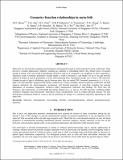Geometry-function relationships in meta-foils
Author(s)
Moser, H. O.; Jian, L. K.; Kalaiselvi, S. M. P.; Virasawmy, S.; Cheng, X. X.; Banas, A.; Banas, K.; Heussler, S. P.; Bahou, M.; Chen, H. S.; Wu, Bae-Ian; Hua, Wei; Yi, Zhu; ... Show more Show less
DownloadMoser-2010-Geometry-function relationships in meta-foils.pdf (4.481Mb)
PUBLISHER_POLICY
Publisher Policy
Article is made available in accordance with the publisher's policy and may be subject to US copyright law. Please refer to the publisher's site for terms of use.
Terms of use
Metadata
Show full item recordAbstract
Meta-foils are all-metal free-standing electromagnetic metamaterials based on interconnected S-string architecture. They provide a versatile applications' platform. Lacking any substrate or embedding matrix, they feature arrays of parallel upright S-strings with each string longitudinally shifted by half an S compared to its neighbour to form capacitance-inductance loops. Geometric parameters include length a, width b, thickness t, and height h of an S, the gap between adjacent S-strings d, and the periodicity p of the interconnecting lines. Equidistant strings at p=1 form a 1SE meta-foil. Grouped in pairs of gap d, exhibiting a gap dp between pairs, they are named 2SP. Geometric parameters a, b, t, h, d, dp, pS(E or P) and materials' properties like electric conductivity, Young's modulus, thermal expansion coefficient, and heat capacity determine the electromagnetic, mechanical, and thermal properties of meta-foils including the spectral dependence of resonance frequencies, refractive index, transmission, reflection, and bending. We show how the frequency and transmission of left-handed pass-bands depend on a, p, and dp, the pSP geometry exhibiting higher resonance frequency and transmission. Equivalent circuit considerations serve to explain physical reasons. We also demonstrate mechanical behavior versus p and dp justifying the design of a cylindrical hyperlens depending on bent meta-foils.
Date issued
2010-04Department
Massachusetts Institute of Technology. Research Laboratory of ElectronicsJournal
Proceedings of SPIE--the International Society for Optical Engineering
Publisher
SPIE
Citation
H. O. Moser, L. K. Jian, H. S. Chen, S. M. P. Kalaiselvi, S. Virasawmy, X. X. Cheng, A. Banas, K. Banas, S. P. Heussler, M. Bahou, B.-I. Wu, Wei Hua and Zhu Yi, "Geometry-function relationship in meta-foils", Proc. SPIE 7711, 771119 (2010); doi:10.1117/12.855094 © 2010 SPIE
Version: Final published version
ISSN
0277-786X